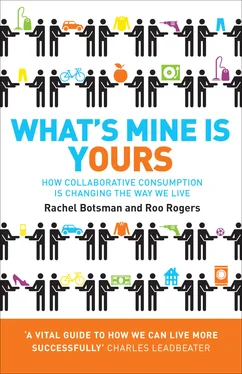We live in a world where our drawers, closets, walk-in wardrobes, attics, garages, sheds and cellars are bloated with mountains of objects we rarely use and forget we even have. By the early 1990s, American families had, on average, twice as many possessions as they did twenty-five years earlier. [50] Jon Mooallem, ‘The Self-Storage Self’, The New York Times (2 September 2009), www.nytimes.com/2009/09/06/magazine/06self-storage-t. html?pagewanted=1&_r=1.
So much stuff has been bought that it doesn’t fit into our homes anymore, and so we rent storage to extend the capacity to own more things. Just as Cyril Northcote Parkinson, a British civil servant, mused in The Economist in 1955 that ‘Work expands so as to fill the time available for completion,’ many of us fall victim to Parkinson’s Law when it comes to storage: more space increases our tendency to acquire more stuff. Just as plastic migrates to the Great Pacific Garbage Patch, these things get stored away, out-of-sight, out-of-mind.
If you’ve ever travelled from an airport into a city, say London or New York, and noticed the abundance of self-storage warehouses along the route, you begin to see the extent of the problem. These buildings sit on the sides of orbital motorways, sprout from the landscape of suburbia or are wedged into commercial strips in a city’s central core. Regardless of their location, they look the same: grey, massive cinder blocks with halogen lamps glaring 24/7.
In 1964, Russ Williams, a Texas oil industry businessman and avid fisherman, got the idea to open ‘mini-warehouses’ called the A–1 U-Store-It U-Lock-It U-Carry the Key from his own need to store boats and oil field equipment securely but accessibly. He designed the first facility based on the pattern of side-by-side garages often found in apartment complexes with block partitions and panel garage doors. It was just one hundred feet by thirty feet in size and was painted yellow and black to draw attention to it. Williams realized that his residential customers wanted to store not just boats but items they did not have room for in their homes. The idea caught on so fast that it was hard to keep up with the demand. Williams built more and more facilities until he eventually owned (with various partners) 2,500 across the United States.
Today there are more than 53,000 personal storage facilities – more than seven times the number of Starbucks – in the United States. This amounts to a staggering 2.35 billion square feet or more than 38,000 football fields put together in America alone. [51] Statistics on growth and size of the self-storage industry come from the Self Storage Association. Last checked on February 2010, www.selfstorageassociation.org.
If you put out your arms, you create about seven square feet around you. That is roughly how much self-storage space there is for every man, woman and child in America. It means every single person in the country could comfortably stand together inside self-storage units. [52] Chris Arnold, ‘Americans Keeping More Possessions “Off-Site”’, for a segment on National Public Radio (20 May 20 2005), www.npr.org/templates/story/story.php?storyId=4660790.
And self-storage is now a $22 billion-per-year industry in the United States – surpassing domestic Hollywood box-office sales. On average we spend more on self-storage than milk, coffee and even beer. Rentable storage has increased by 740 percent in the past two decades. [53] Martin John Brown, ‘Too Much Stuff! America’s New Love Affair with Self-Storage’, AlterNet (June 4, 2008), www.alternet.org/work place/86998.
As Chris Sonne, a storage expert at Cushman & Wakefield, comments, ‘That’s two or more self-storage facilities opening every day for fifty years. That beats McDonald’s.’ About 30 percent of the storage boom comes from use by businesses storing things such as payment records, office equipment, and inventory, but the rest of the expansion has come from people storing possessions that no longer fit in their homes. [54] Ibid.
So what are we cramming into these storage units? Camping gear, lawn mowers, roller skates, pet cages, bread makers and other electronic gadgets, back issues of National Geographic magazine, old souvenirs, children’s bicycles, a computer monitor that just might work one day, a clarinet we played in primary school, years of bank receipts, an old sofa – the list goes on. But for the most part, it is ‘just stuff’ we no longer want cluttering our homes but pay to store anyway.
Rich Ellmer is a self-storage veteran who has owned and operated more than two hundred Cypress Storage Units in Austin, Texas, since 1976. Over the past quarter of a century, Ellmer has seen the same storyline unfold many times. People rent a space and start off thinking they will rent it for a month or two. They end up keeping it a lot longer, for years, sometimes more than a decade, with some renters never clearing out their stuff. Every month, a fee is automatically debited from their bank account, on average ranging from $99 to $195 depending on the amount of storage. ‘Generally, after six to eight months, the money people pay for the storage exceeds the value of the items,’ Ellmer says. ‘It’s easier just to write a cheque for another month and pay. People just don’t want to be bothered.’ Gradually, however, some of his tenants realize that the stuff they are keeping is worth less than what they are paying to store it and one day just ask for it all to be thrown away. [55] Story of Rich Ellmer comes from Rob D’Amico, ‘What’s in Store? Has Mini-Storage Become Mega-Storage’, Austin Chronicle (1 September 2000), http://www.austinchronicle.com/gyrobase/Issue/story?oid=oid%3A78464.
Конец ознакомительного фрагмента.
Текст предоставлен ООО «ЛитРес».
Прочитайте эту книгу целиком, купив полную легальную версию на ЛитРес.
Безопасно оплатить книгу можно банковской картой Visa, MasterCard, Maestro, со счета мобильного телефона, с платежного терминала, в салоне МТС или Связной, через PayPal, WebMoney, Яндекс.Деньги, QIWI Кошелек, бонусными картами или другим удобным Вам способом.
Statistics on online networks taken from ‘A Day on the Internet’, www.onlineeducation.net/internet.
Abha Bhattarai, ‘Bike-Sharing: Cycling to a City Near You’, Fast Company (26 June 2009), www.fastcompany.com/blog/abha-bhattarai/abha-bhattarai/bike-sharing-cycling-city-near-you.
Statistics on Zilok taken from Reuters release, ‘Rent Your Way Out of the Credit Crunch Online’ (5 December 2008), http://www.reuters. com/article/idUSTRE4B44DE20081205.
Statistics on bartering taken from William Lee Adams, ‘Bartering: Have Hotel, Need Haircut’, Time (2 November 2009), http://www.time.com/time/magazine/article/0,9171,1931665,00.html.
Statistics on Freecyle taken from Freecycle press release, ‘Largest Environmental Web Community in the World’ (9 September 2008), www.freecycle.org/pressreleases/08-09-09_Freecycle_press_release. pdf?.
Statistics on CouchSurfing: http://traffic.alexa.com/graph?w=900&h =500&r=3m&y=p&u=CouchSurfing.org/&u=hospitalityclub. org&u=globalfreeloaders.com&u=place2stay.net&u=servas.org and www.CouchSurfing.org/statistics.html.
Читать дальше












